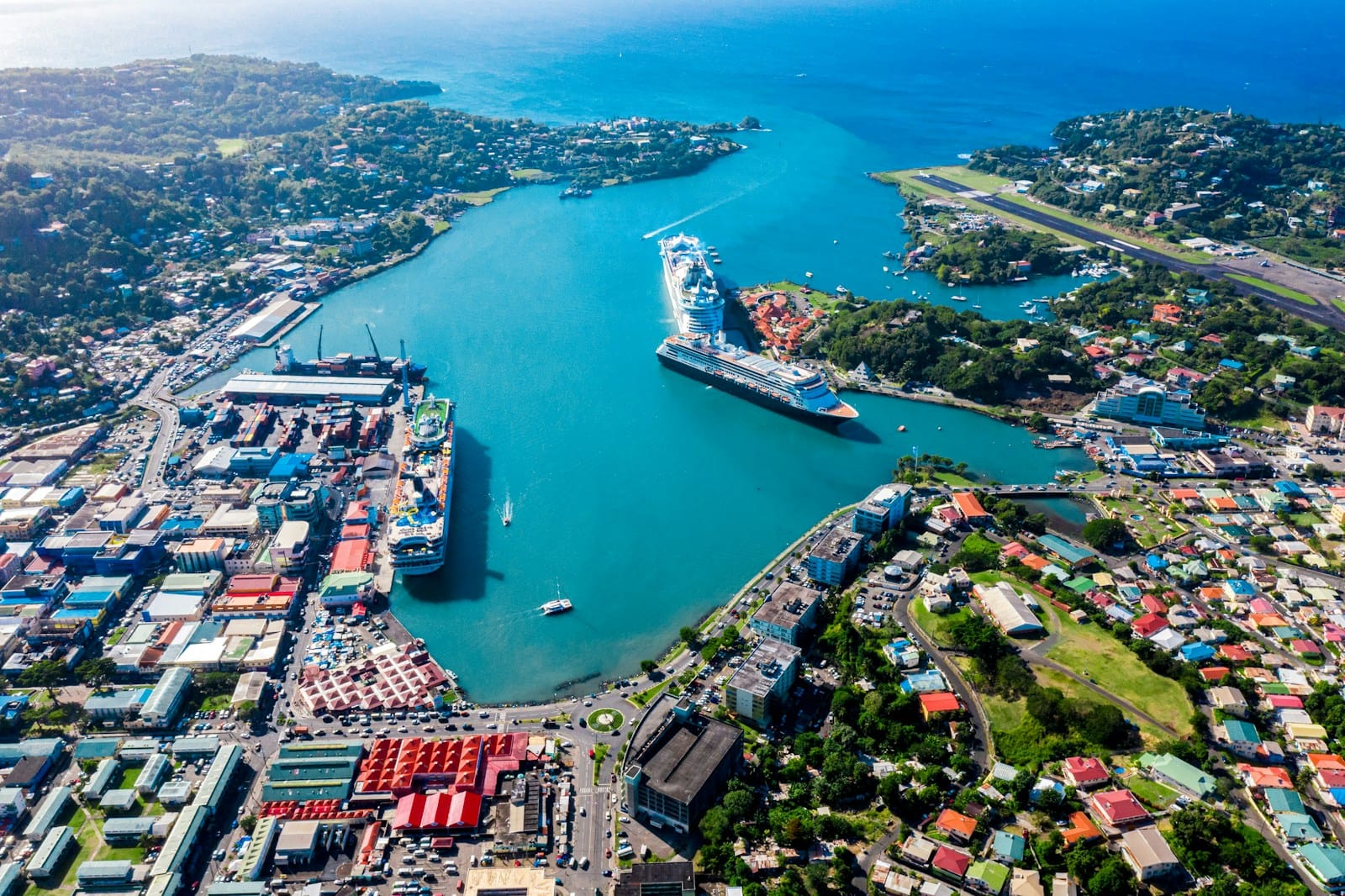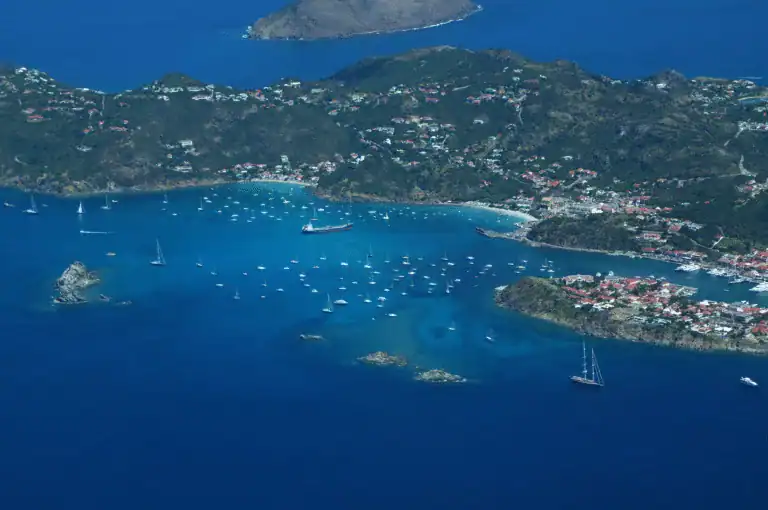St Lucia Travel Guide: Caribbean Peaks, Culture & Coastlines
Explore St Lucia Travel Guide
Rising from the eastern Caribbean in a flourish of green volcanic ridges and turquoise bays, St Lucia captures both tropical serenity and Creole vitality. Its twin Pitons tower over Soufrière Bay, fishing villages hum to steel-pan rhythms, and rainforest trails descend to hidden waterfalls. This St Lucia travel guide reveals the island’s wild beauty and modern charm—from hot-spring mud baths to coral reefs, from cocoa estates to sunset sails.
For a seamless trip, browse top-rated St Lucia tours and curated activities that highlight the best things to do across the island.
Exploring St Lucia
Anse La Raye | Canaries | Castries | Choiseul | Dennery | Gros Islet | Laborie | Micoud | Soufrière | Vieux Fort
💡Quick Facts:
Continent: North America (Caribbean region).
Country: Saint Lucia (ISO code: LC).
Area: 617 km² / 238 mi² (CIA World Factbook).
Population: ~179,000 (2024 estimate; World Bank).
Capital: Castries.
Major regions: Castries Quarter, Soufrière, Vieux Fort, Gros Islet.
Official language: English (EN); Saint Lucian Creole French (Kweyòl [LCF]).
Currency: East Caribbean Dollar (XCD) (Eastern Caribbean Central Bank).
Time zone: UTC – 4 (AST).
Major airports: Hewanorra International Airport (UVF); George F.L. Charles Airport (SLU).
Climate summary: Tropical maritime; dry season Dec–May, wet season Jun–Nov. Prone to hurricanes (Jul–Oct).
Known for: UNESCO Pitons Management Area, Soufrière volcanic caldera, Jazz & Arts Festival, Caribbean beaches.
Major religions: Christian (primarily Roman Catholic, Protestant).
🛂Arrival Info:
Entry requirements: Most travelers from the U.S., U.K., E.U., and Commonwealth countries may enter visa-free for up to 6 weeks (Government of Saint Lucia Immigration Dept.).
eVisa system: None; extensions available locally through the Immigration Department.
Customs restrictions: Duties on alcohol & tobacco above limits; prohibited imports include drugs and restricted weapons (Customs & Excise Department).
Arrival form: Digital immigration card recommended for air arrivals (Travelslu.govt.lc).
Entry fees: None for short-stay tourists.
🏥Health Info:
Vaccines: Routine vaccines recommended; Yellow Fever vaccine required if arriving from endemic areas.
Health advisories: Zika virus present (low risk). COVID-19 measures suspended (2023).
Hospitals: Victoria Hospital (Castries), St Jude Hospital (Vieux Fort); private clinics in Rodney Bay.
Tap water: Generally treated in urban areas; bottled water recommended elsewhere.
🚑 Check travel insurance options for travel emergencies, delays, and medical needs abroad — Get coverage here
💉 Stay Informed with Official Updates: WHO – International Travel & Health | CDC – Travel health updates
🚨Travel Advisory:
Current level: Exercise normal precautions.
Risks: Petty theft in tourist zones, hurricane season June–November.
Civil rights: Same-sex sexual activity decriminalized (2022); anti-discrimination laws limited (ILGA World)
🌍Track Real-Time Official Updates: US Travel Advisory | UK Foreign Travel Advice | Government of Canada | NZ SafeTravel
🥳Holidays:
1 Jan — New Year’s Day.
2 Jan — New Year Holiday.
22 Feb — Independence Day.
18 Apr — Good Friday (movable).
21 Apr — Easter Monday (movable).
1 May — Labour Day.
9 Jun — Whit Monday (movable).
19 Jun — Corpus Christi (movable).
1 Aug — Emancipation Day.
13 Dec — National Day (Patron Saint Lucy).
25 Dec — Christmas Day.
26 Dec — Boxing Day.
Official holiday calendar: Government of Saint Lucia.
💰Visitor Info:
Currency & payments: XCD is official; USD widely accepted in resorts.
Tipping & tourist levies: Tipping commonly 10–15% if service not included; check hotel resort fees.
Budget guidelines: Budget travel ~US $70–100 per day; mid-range US $150–250; luxury from US $400+.
Duty-free & taxes: Check official tourism board portals for recent duty-free allowances.
Tourist tax: US $3–6 per night per guest (Hotel Accommodation Tax).
🛫Airports:
Hewanorra International Airport (UVF) – Main long-haul hub in the south (Vieux Fort)
George F.L. Charles Airport (SLU) – Regional flights near Castries
Direct flights from U.S., Canada, UK, and other Caribbean islands
🧳 Delayed or canceled flight? Check if you’re eligible for compensation
🚍Transport:
Driving rules: Left side; temporary permit required (Transport Department).
Public transit: Private minibuses link Castries, Vieux Fort, Soufrière.
Ride services: Registered taxis and local apps operate under licensing rules.
Ferry links: Martinique and Guadeloupe via Express des Îles.
🚗 Book reliable airport transfers and in-city rides in advance. Reserve your ride here
🛰️Connectivity:
Mobile carriers: Digicel and Flow.
SIM / eSIM: Available at airports and retail outlets.
Power: 230 V, 50 Hz; Type G (British 3-pin) plugs.
🛜 Stay connected abroad with affordable eSIM data packs. Get your eSIM here
📜Laws & Etiquette:
Drinking age: 16.
Smoking: Banned in enclosed public spaces.
Dress: Casual but modest outside resorts.
Drugs: Marijuana decriminalized for personal use (2020) (Government of Saint Lucia).
Drone rules: Permit required (Eastern Caribbean Civil Aviation Authority – ECCAA).
👮Emergency Info:
Emergency numbers: Police 999 / Fire 911 / Ambulance 758-451-7000.
Tourism Authority: Saint Lucia Tourism Authority.
🗺️US/UK Embassies Abroad: US Embassies | UK Embassies
🏛️ Embassy locator tools: Embassies Worldwide
🌞Weather:
Average temperatures: 26–31 °C / 79–88 °F.
Rainfall: Dry season ≈ 60 mm per month; wet season ≈ 250 mm per month.
Hurricane season: June–November (Saint Lucia Meteorological Service).
🌦️ Stay prepared—check the weather forecast for your destination — Weather Forecast
St Lucia by Region — Where to Go
Though only 27 miles long, St Lucia divides naturally between the tranquil, volcanic south and the energetic north. Each area offers a distinct atmosphere, scenery, and pace.
North: Rodney Bay & Gros Islet
The north is the island’s social hub, blending beaches, marinas, and nightlife. Rodney Bay’s sheltered crescent beach invites calm swimming and sailing, while Gros Islet hosts the famous Friday Night Jump-Up—grilled seafood, rum stalls, and dancing in the streets until dawn. Upscale resorts, modern malls, and the national cricket stadium sit nearby.
Central: Castries & the Rainforest Interior
Castries, the capital, wraps around a natural harbor lined with bright colonial warehouses. Vendors fill the Central Market with spices and fresh fruit, and Morne Fortune overlooks the bay with panoramic views. Inland, rainforest cloaks the mountainous interior; trails through Edmund Forest Reserve lead to giant ferns, parrots, and cascading streams beneath Mount Gimie.
South: Soufrière, Choiseul & the Piton Valley
The south defines St Lucia’s identity. Soufrière rests beneath the UNESCO-listed Pitons, flanked by botanical gardens and geothermal springs. Choiseul, a traditional pottery village, stretches along black-sand beaches where fishermen mend nets under almond trees. Roads twist past cocoa farms and hillside plantations toward hidden coves and viewpoints.
East Coast: Dennery & Praslin Bay
Facing the Atlantic, the east coast feels raw and untamed. Dennery’s Saturday Fish Fiesta turns the waterfront into a grill-smoke carnival, and nearby Sault Falls pours into a cool jungle pool. Offshore reefs attract divers, while inland banana estates show the island’s agricultural roots.
West Coast: Marigot Bay & Canaries
Marigot Bay, fringed with palms and yachts, is one of the Caribbean’s most photogenic harbors. The coastal road south passes cliff viewpoints and fruit stalls before reaching the quiet village of Canaries, where life slows to the rhythm of sea and song.
Top Places to Visit in St Lucia
Soufrière & the Piton Mountains
The twin peaks Gros Piton (798 m) and Petit Piton (743 m) form St Lucia’s iconic skyline. Guided hikes up Gros Piton reveal sweeping views of forest, reef, and neighboring islands. Sunset cruises showcase their silhouettes glowing crimson above the sea.
Sulphur Springs Park
Known as the world’s only “drive-in volcano,” this geothermal site steams with bubbling mud and mineral pools. Visitors can bathe in gray-black clay believed to rejuvenate skin and ease sunburn.
Diamond Falls Botanical Gardens
Tucked behind Soufrière, these gardens display tropical blooms, fruit trees, and a six-colored waterfall stained by volcanic minerals. Nearby mineral baths date back to the 18th century.
Marigot Bay
A natural harbor encircled by forested hills, Marigot Bay once sheltered British warships. Today it welcomes catamarans and features waterfront dining, kayaking, and calm swimming coves.
Pigeon Island National Park
Linked to the mainland by a causeway, this park combines beaches, hiking paths, and 18th-century British fort ruins. From Signal Hill, visitors see Martinique shimmering across the channel.
Anse Chastanet & Anse Mamin Beaches
Set near Soufrière, these black-sand beaches mix snorkeling reefs with artfully designed eco-resorts. Anse Mamin’s secluded shoreline appeals to couples and photographers alike.
Castries Market
Morning bustle fills the capital’s open-air market with chatter and color. Handwoven baskets, local coffee, and Creole spices make meaningful souvenirs.
Tet Paul Nature Trail
A short, moderate hike that delivers one of the island’s most celebrated views: both Pitons framed by jungle and sea. Local guides share medicinal plant lore and family farming stories.
How to Choose Where to Go in St Lucia
- For Romance & Relaxation: Stay around Soufrière or Marigot Bay for luxury resorts, spa retreats, and sunset dining under the Pitons.
- For Adventure Seekers: Base yourself near Dennery or the rainforest interior to zip-line, hike, or canyon.
- For Beach Life & Nightlife: Choose Rodney Bay for long beaches, bars, and sailing schools.
- For Local Culture: Spend time in Choiseul or Castries Market to meet artisans and experience daily island rhythm.
- For Families: Combine Pigeon Island’s calm waters with short rainforest walks and catamaran day trips.
Getting Around St Lucia — Transport & Travel Tips
- Air Travel: Hewanorra International Airport (UVF) in the south serves long-haul flights; George F.L. Charles Airport (SLU) near Castries handles regional hops. Inter-island connections to Barbados or Martinique are frequent.
- Taxis & Transfers: Official taxis display red plates; fares are fixed by zone. Pre-book transfers for airport journeys—roads are scenic but winding.
- Rental Cars: Driving is on the left. Temporary permits are required (available at rental desks). 4WD recommended for rural or steep routes.
- Public Buses & Minibuses: Color-coded vans run inexpensive routes between villages. Ask locals for stops; schedules are flexible.
- Ferries & Water Taxis: Speedboats link Soufrière, Marigot Bay, and Rodney Bay—often faster than driving. Regional ferries connect to Martinique and Dominica.
Travel Budget & Costs
- Budget Travelers: Approx. US $60–100 per day covers guesthouses, local food, and shared taxis.
- Mid-Range: US $150–250 per day adds boutique hotels, car rentals, and guided tours.
- Luxury: US $400 and up secures beachfront villas, private charters, and fine dining.
Money-Saving Tips: Eat at roadside grill stands, visit attractions in combo packages, and travel in shoulder months (May–June or October–November). Use EC dollars for better local prices than USD.
Best Time to Visit St Lucia
- Winter (December–April): Dry season with calm seas and cultural events like St Lucia Jazz Festival. Peak prices but ideal weather.
- Summer (May–August): Hotter and more humid; vibrant carnivals and mango season. Afternoon rain showers refresh the hills.
- Autumn (September–November): Fewer crowds and lower rates; monitor tropical-storm forecasts.
- Spring (November–December transition): Rainforest vivid, waterfalls strong, perfect for hikers.
Festivals & Cultural Events
- St Lucia Jazz & Arts Festival (May): International performers fill venues from Pigeon Island to Soufrière, blending jazz with Caribbean fusion.
- Carnival (July): Weeks of parades, costumes, and Soca competitions culminating in the Castries street parade.
- Jounen Kwéyòl (Creole Day, October): Island-wide celebration of Creole language, food, and dress—villages host live bands and folk dishes.
- Atlantic Rally for Cruisers (November): Yachts race from the Canary Islands to Rodney Bay, bringing sailors from Europe and the Americas.
- La Rose & La Marguerite Festivals (August–October): Two rival flower societies reenact colonial-era pageantry with song and satire.
Must-See Experiences Across St Lucia
- Soak in Sulphur Springs Mud Baths: Warm volcanic pools near Soufrière offer a rejuvenating dip.
- Sail Along the West Coast: Catamarans glide past fishing villages, coral reefs, and sunset Piton views.
- Zip-Line Through the Rainforest: Canopy tours near Babonneau and Dennery deliver adrenaline and birdsong.
- Tour a Cocoa Estate: Learn bean-to-bar chocolate making at Morne Coubaril or Fond Doux Plantation.
- Snorkel the Marine Reserves: Anse Chastanet and Soufrière Bay feature vibrant coral gardens and parrotfish.
- Hike Gros Piton: A challenging 3-hour trail with licensed guides and sweeping Caribbean views.
- Sample Rum at the Distillery: Local brands like Chairman’s Reserve showcase ageing craft and blends.
- Join a Friday Street Party: Gros Islet’s weekly Jump-Up brings locals and travelers together to dance and eat by the sea.
For a seamless trip, browse top-rated St Lucia tours and curated activities that highlight the best things to do across the island.
We may receive a small affiliate commission when you book through our recommended links — helping us keep guides free, at no cost to you.
Adventure & Water Activities
- Diving & Snorkeling: Marine parks around Soufrière protect reefs teeming with sponges, turtles, and seahorses. Beginners train in Rodney Bay; advanced divers explore Superman’s Flight below Petit Piton.
- Kayaking & SUP: Calm waters of Marigot Bay and Pigeon Island suit paddle adventures with mangrove views.
- Hiking & Climbing: Trails range from easy forest loops to the rugged Piton summit routes. Early starts avoid heat.
- Kitesurfing & Windsurfing: Atlantic breezes at Cas en Bas and Vieux Fort create prime conditions for experts.
- Whale & Dolphin Watching: Boat tours spot spinner dolphins year-round and humpbacks in winter.
National Parks & Outdoor Adventures
- Piton Management Area (UNESCO): Protects marine and terrestrial habitats with endemic species and reefs.
- Maria Islands Nature Reserve: A restricted islet off Vieux Fort hosting rare St Lucia whiptail lizards and unique plants.
- Edmund Forest Reserve: Dense rainforest hikes with giant gommier trees and waterfalls.
- Morne Fortune Historic Park: Castries’ hilltop viewpoint and colonial fortifications.
- Des Cartiers Rainforest Trail: Birdwatchers seek the endemic St Lucia parrot amid towering mahogany.
History & Heritage
St Lucia’s story weaves Arawak and Carib roots with colonial struggles and modern independence.
- Pre-Colonial Era: The Arawak and Carib peoples settled long before Europeans, leaving petroglyphs and ceramic artifacts.
- Colonial Rivalry: Britain and France fought over St Lucia 14 times between 1660 and 1814; both languages and laws still linger.
- Emancipation & Creole Identity: Slavery was abolished in 1834; Creole culture and Catholic traditions flourished.
- Independence: Gained from the United Kingdom in 1979; today St Lucia is a Commonwealth nation with a parliamentary system.
- Modern Culture: Music blends Soca, Calypso, and Reggae; artisans produce wood carvings and batik inspired by volcanic landscapes.
St Lucia at a Glance — Quick Travel Insights
- Language: English official; Kwéyòl Creole widely spoken.
- Currency: Eastern Caribbean Dollar (XCD); USD accepted in tourist areas.
- Religion: Predominantly Christian (Catholic majority).
- Time Zone: Atlantic Standard Time (UTC -4).
- Visa: Many nationalities receive visa-free entry for up to 6 weeks. Check government immigration site before travel.
- Power Sockets: 230 V / 50 Hz using UK-style Type G plugs.
- Emergency Numbers: Police 999; Ambulance 911.
- Average Costs: Meals US $10–40; taxis US $10–25 per short trip.
Travel Safety & Cultural Etiquette
Health & Safety
Tap water is generally safe in resorts, but bottled water is recommended in rural areas. Use reef-safe sunscreen and insect repellent. Hiking guides are required for the Piton trails.
Scams & Street Tips
Vendors can be persistent; a polite “no thanks” works well. Use licensed taxis and avoid isolated beaches after dark.
Cultural Customs
Greetings matter—say “Good morning” or “Good afternoon.” Casual dress is fine in resorts but avoid beachwear in towns and churches.
Local Laws
Possession of illegal drugs carries severe penalties. Public nudity is not allowed. Same-sex relationships exist within a conservative social context; discretion is advised.
Final Planning Checklist
- Local SIM & Apps: Digicel or Flow SIM
- Travel Documents: Valid passport (minimum 6 months validity) and return ticket.
- Insurance: Comprehensive policy covering medical care and cancellations.
- Currency & Payments: Carry small bills in XCD; ATMs in Castries and Rodney Bay.
- Packing: Light cotton clothing, rain jacket, swim gear, reef-safe sunscreen.
- Electronics: UK-style adapter (Type G) and portable charger.
- Health Items: Motion pills for curvy roads, mosquito repellent, first-aid kit.
- Tipping: 10–15 % in restaurants if not included; small tips appreciated for guides and drivers.
- Connectivity: Wi-Fi common in hotels, limited in rural zones—carry a hotspot if working remotely.
- Responsible Travel: Support small guesthouses, eco-resorts, and community-based tours.
Plan Smarter, Travel Better
St Lucia rewards travelers who slow down and explore beyond resort walls. Whether you’re chasing waterfalls, learning Creole cooking, or cruising past the Pitons at sunset, each experience reveals a different rhythm of island life. Plan routes that balance rest with discovery, and you’ll return with more than photos—memories of warmth, color, and conversation. Thoughtful preparation turns this St Lucia travel guide into your blueprint for genuine connection.
Choose Your Next Adventure
- Barbados: Pair your St Lucia escape with Barbados for historic towns, coral beaches, and direct short flights.
- Dominica: Just north, Dominica offers volcanic hikes, boiling lakes, and diving with whales.
- Martinique: A quick ferry ride brings French-Caribbean flair, patisseries, and hiking trails through Mount Pelée National Park.
- Grenada: Known as the “Spice Isle,” it blends beaches with nutmeg plantations and shipwreck diving.
- Antigua & Barbuda: Great for sailing week festivals and calm turquoise lagoons.
It’s Time to Experience St Lucia
Ready to plan your journey? Discover top-rated St Lucia tours and travel ideas to make it happen. Some links may be affiliate-based — we only recommend trusted partners, and it never costs you extra.









